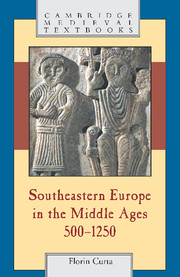Book contents
- Frontmatter
- Contents
- List of maps
- Acknowledgments
- Note on transliteration, names, dates, and words
- Chronology
- List of abbreviations
- Introduction
- 1 The end of Late Antiquity or the beginning of the Middle Ages (c. 500–c. 600)?
- 2 Southeast European “Dark Ages” (c. 600–c. 800)
- 3 The rise of new powers (800–900)
- 4 Iron century or golden age (900–1000)?
- 5 The first Byzantine century (1000–1100)
- 6 The second Byzantine century (1100–1200)
- 7 Between the Crusade and the Mongol invasion (1200–1250)
- 8 Conclusions and lingering questions
- Select Bibliography
- Index
- Cambridge Medieval Textbooks
7 - Between the Crusade and the Mongol invasion (1200–1250)
Published online by Cambridge University Press: 05 June 2012
- Frontmatter
- Contents
- List of maps
- Acknowledgments
- Note on transliteration, names, dates, and words
- Chronology
- List of abbreviations
- Introduction
- 1 The end of Late Antiquity or the beginning of the Middle Ages (c. 500–c. 600)?
- 2 Southeast European “Dark Ages” (c. 600–c. 800)
- 3 The rise of new powers (800–900)
- 4 Iron century or golden age (900–1000)?
- 5 The first Byzantine century (1000–1100)
- 6 The second Byzantine century (1100–1200)
- 7 Between the Crusade and the Mongol invasion (1200–1250)
- 8 Conclusions and lingering questions
- Select Bibliography
- Index
- Cambridge Medieval Textbooks
Summary
The passage of the first three crusades through the Balkans produced both destruction and opportunities for the local leaders to assert their independence, especially in Bulgarian and Serbian territories under direct Byzantine control. In 1096, the pilgrims led by Walter the Penniless plundered the countryside around Belgrade, and they were in turn attacked by the locals. The pilgrims sacked a little town near Semlin, while bands of “infidel” Pechenegs, perhaps auxiliaries in Byzantine service, harassed the pilgrims and forced them to hide in the “Bulgarian forest.” The pilgrims of Peter the Hermit followed the same route from the Hungarian–Byzantine border at Semlin to Niš, with a number of bloody skirmishes with the locals on their way. Skirmishes with the locals are also mentioned in relation to the crusaders who in 1098 followed a land route from Aquileia through northern Istria into Croatia under the leadership of Raymond of St. Gilles, Count of Toulouse. Under permanent attack by bands of locals emerging from the mountains of “Sclavonia,” Raymond stayed with his rearguard and ordered the mutilation of prisoners in order to deter further attacks. Raymond of Aguilers, the chronicler of the count of Toulouse, describes the local population as “aggressive and primitive,” a “wild people” with no knowledge of God. He further distinguished between the inhabitants of the local towns, who apparently spoke a Latin idiom recognized as such by the crusaders, and natives living inland who “employ the Slavonic tongue and have the habits of barbarians.
- Type
- Chapter
- Information
- Southeastern Europe in the Middle Ages, 500–1250 , pp. 366 - 414Publisher: Cambridge University PressPrint publication year: 2006



